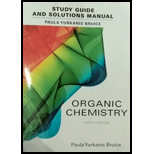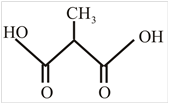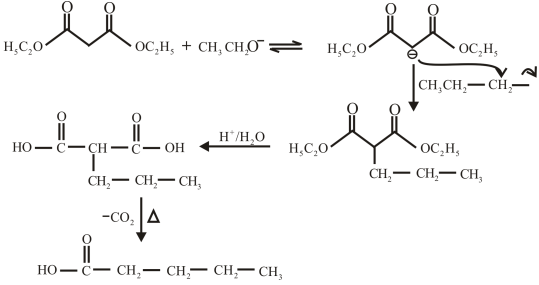
Concept explainers
(a)
Interpretation: The structure of given compounds has to be drawn.
ethylacetoacetate
Concept introduction: The
Carboxylate ion with a carbonyl group at the 3-position loses
(a)
Answer to Problem 48P
The structure of ethyl acetoacetae is,

Explanation of Solution
The name given compound ethyl acetoacetate ends with ate. This means the given compound must contain an ester group. The name of compound starts with ethyl group, this means ethyl group is attached to the oxygen of an ester group. The acetone group is attached with the carbonyl carbon of an ester group. The structure of ethyl acetoacetae is,

(b)
Interpretation: The structure of given compounds has to be drawn.
α-methylmalonicacid
Concept introduction: The
Carboxylate ion with a carbonyl group at the 3-position loses
(b)
Answer to Problem 48P
The structure of α-methylmalonic acid is,

Explanation of Solution
The structure of malonic acid is two

(c)
Interpretation: The structure of given compounds has to be drawn.
β-keto ester
Concept introduction: The
Carboxylate ion with a carbonyl group at the 3-position loses
(c)
Answer to Problem 48P
The structure of β-keto ester is,

Explanation of Solution
The given compound β-keto ester contains a keto group and an ester group. The structure of β-keto ester is,

(d)
Interpretation: The structure of given compounds has to be drawn.
The carboxylic acid obtained from malonic ester synthesis when the
Concept introduction: The
Carboxylate ion with a carbonyl group at the 3-position loses
(d)
Answer to Problem 48P
The structure of enol form of cyclopentanone is,

Explanation of Solution
The compound cyclopentanone contain a keto group. After the keto enol tautomerism the keto compound converted into an alcohol and a double bond. The structure of enol form of cyclopentanone is,

(e)
Interpretation: The structure of given compounds has to be drawn.:
The structure of enol form of cyclopentanone
Concept introduction: The
Carboxylate ion with a carbonyl group at the 3-position loses
(e)
Answer to Problem 48P
The structure of the carboxylic acid obtained from malonic ester synthesis by using propyl bromide is,

Explanation of Solution
The proton removed from the alpha carbon of malonic ester by the base. Then, there is a nucleophilic substitution reaction takes place between the propyl bromide and carbanion of malonic ester. The third step is acidic hydrolysis of an ester to form carboxylic acid. The fourth step is decarboxylation of the compound to form the desired product. The reaction and structure of given compound is,

Want to see more full solutions like this?
Chapter 17 Solutions
Student's Study Guide and Solutions Manual for Organic Chemistry
- Would the following organic synthesis occur in one step? Add any missing products, required catalysts, inorganic reagents, and other important conditions. Please include a detailed explanation and drawings showing how the reaction may occur in one step.arrow_forward(a) Sketch the 'H NMR of the following chemical including the approximate chemical shifts, the multiplicity (splitting) of all signals and the integration (b) How many signals would you expect in the 13C NMR? CH3arrow_forwardDraw the Show the major and minor product(s) for the following reaction mechanisms for both reactions and show all resonance structures for any Explain why the major product is favoured? intermediates H-Brarrow_forward
- 3. Draw ALL THE POSSBILE PRODUCTS AND THE MECHANISMS WITH ALL RESONANCE STRUCTURES. Explain using the resonance structures why the major product(s) are formed over the minor product(s). H₂SO4, HONO CHarrow_forward7. Provide the product(s), starting material(s) and/or condition(s) required for the No mechanisms required. below reaction HO + H-I CI FO Br2, FeBr3 O I-Oarrow_forward6. Design the most efficient synthesis of the following product starting from phenot Provide the reaction conditions for each step (more than one step is required) and explain the selectivity of each reaction. NO MECHANISMS ARE REQUIRED. OH step(s) CIarrow_forward
- What is the skeletal structure of the product of the following organic reaction?arrow_forwardIf a reaction occurs, what would be the major products? Please include a detailed explanation as well as a drawing showing how the reaction occurs and what the final product is.arrow_forwardWhat is the major organic product of the following nucleophilic acyl substitution reaction of an acid chloride below?arrow_forward
 Chemistry for Today: General, Organic, and Bioche...ChemistryISBN:9781305960060Author:Spencer L. Seager, Michael R. Slabaugh, Maren S. HansenPublisher:Cengage Learning
Chemistry for Today: General, Organic, and Bioche...ChemistryISBN:9781305960060Author:Spencer L. Seager, Michael R. Slabaugh, Maren S. HansenPublisher:Cengage Learning Organic Chemistry: A Guided InquiryChemistryISBN:9780618974122Author:Andrei StraumanisPublisher:Cengage Learning
Organic Chemistry: A Guided InquiryChemistryISBN:9780618974122Author:Andrei StraumanisPublisher:Cengage Learning

